This set of Air Pollution Control Multiple Choice Questions & Answers (MCQs) focuses on “Particulate Collection Efficiency”.
1. What does the operating efficiency of equipment collecting particulates measure?
a) System performance
b) System failure
c) Perfect fit of the equipment
d) Comparison to emission standards
View Answer
Explanation: The operating efficiency measures the performance of the system. It measures the weight of particulates collected by the system to the weight of particulates entering the system. The system, here, is the equipment used for collection.
2. What does the collection efficiency of particulate recovery system measure?
a) A comparison to emission standards
b) Actual performance of the equipment
c) How efficient the equipment is
d) How many particulates are collected
View Answer
Explanation: The collection efficiency measures the actual performance of the system. It shows the efficiency with which it retains particulates that enter the equipment. It is also known as operating efficiency.
3. Which of the following is the most common way of expressing the gravimetric efficiency?
a) Ratio of mass of gas collected to that entering
b) Ratio of the volume of gas collected to that entering
c) Ratio of weight of particulates collected to that entering
d) Ratio of the density of particulates collected to that entering
View Answer
Explanation: The gravimetric efficiency is defined as the ratio of the mass of particulates collected to the mass of particles entering the system. It is expressed as a percentage and shows how fitting a particular system is for particulate recovery.
4. What is the definition of collection efficiency?
a) Density of particulates collected
b) Volume of particulates collected
c) Weight of particulates collected
d) Percentage of particulates collected after entering the equipment
View Answer
Explanation: Collection efficiency is the percentage of particulates collected when they enter the equipment. It represents the performance of the equipment. Gravimetric efficiency is more specific.
5. Which of the following represents the equation for gravimetric efficiency?
a) ηT = (Weight of the material collected) * 100 / (Total weight entering equipment)
b) ηT = (Volume of the material collected) / (Total volume entering equipment)
c) ηT = (Weight of the material collected) / (Total weight entering equipment)
d) ηT = (Density of the material collected) / (Total density entering equipment)
View Answer
Explanation: The correct formula representing gravimetric efficiency is:
ηT = (Weight of the material collected) * 100 / (Total weight entering equipment)
Where ηT denotes gravimetric efficiency of the system.
6. The gravimetric efficiency of the equipment is 45%, and the total weight of particulates entering the equipment is 11 kg. What is the weight collected by the equipment?
a) 6.05 kg
b) 4.95 kg
c) 5.5 kg
d) 4.5 kg
View Answer
Explanation: Given,
Gravimetric efficiency, ηT = 45%
Total weight entering equipment = 11 kg
Weight of material collected = x
We know that,
ηT = (Weight of the material collected) / (Total weight entering equipment) * 100
45 = (x / 11) * 100
x = (45 / 100) * 11 = 4.95 kg
7. The weight of particulates collected by equipment is 246 g, and the total amount of particulates entering it is 650 g. What is the gravimetric efficiency of the equipment?
a) 62%
b) 50%
c) 38%
d) 26%
View Answer
Explanation: Given,
Gravimetric efficiency, ηT = x
Total weight entering equipment = 650 g
Weight of material collected = 246 g
We know that,
ηT = (Weight of the material collected) / (Total weight entering equipment) * 100
x = (246 / 650) * 100
x = 0.378 * 100 = 37.8% = 38%
8. The efficiency of the same equipment varies with particle size.
a) True
b) False
View Answer
Explanation: The efficiency of the equipment varies with particle size. Some equipment will not be as thorough at collecting small particles as they are at recovering large particles. This type of efficiency is fractional efficiency.
9. Which of the following factors does fractional efficiency not depend on?
a) Particle density
b) Flow rate of the gas
c) Temperature
d) Composition of particles
View Answer
Explanation: Fractional efficiency does not depend upon particle density. For a particular particle size, fractional efficiency depends upon the nature of the particles, temperature of the gases, and its flow rate.
10. How does the fractional efficiency vary with collection efficiency?
a)
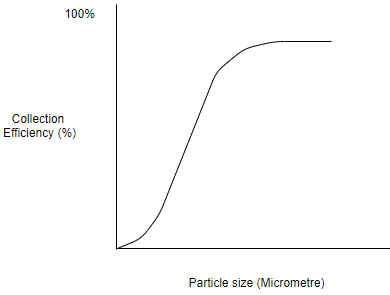
b)
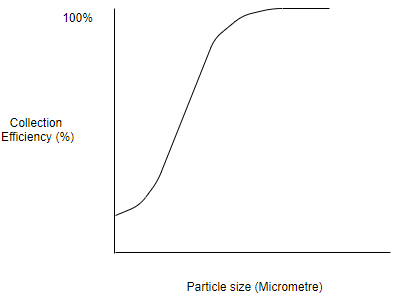
c)
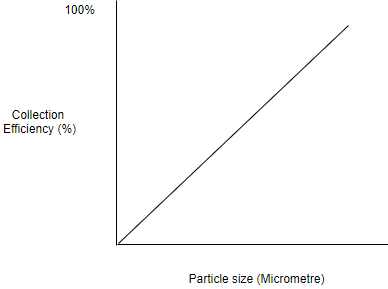
d)
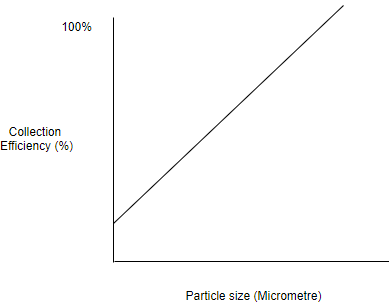
View Answer
Explanation: The fractional efficiency does not vary linearly with collection efficiency. It plateaus at a point lower than 100%. Fractional efficiency does increase with the increase in particle size, as shown in the diagram.

11. What is the formula for fractional efficiency?
a) ηi = (Weight of the material collected) * 100 / (Total weight entering equipment)
b) ηi = (Fraction collected in range ‘i’) * 100 / (Total amount in range ‘i’)
c) ηi = (Fraction collected in range ‘i’) * 100 / (Total amount entering equipment)
d) ηi = (Fraction collected in equipment) * 100 / (Total amount in range ‘i’)
View Answer
Explanation: Fractional efficiency is the efficiency with which the equipment collects particulates in a particular size range. According to this definition, the formula for fractional efficiency is:
ηi = (Fraction collected in range ‘i’) * 100 / (Total amount in range ‘i’)
12. Total amount of dust particles in the size range of 10-15 micrometre entering the equipment is 60g. If the fractional efficiency of the equipment is 61% for this size range, what is the weight of the particles collected?
a) 33 g
b) 35 g
c) 37 g
d) 39 g
View Answer
Explanation: Given,
Total weight of dust particles entering = 60g
Fractional efficiency of the system for the given range, ηi = 61%
Weight of particles collected = x
We know that,
Fractional efficiency = Weight of particles collected / Total weight of particles entering
61 / 100 = x / 60
Therefore, x = 36.6 g = 37 g
13. What is the approximate collection efficiency of the particulate collector based on the information given?
| Sno. | Dust size (microns) | Weight per 100g of dust | Fractional Efficiency |
| 1. | < 25 | 5 | 10 |
| 2. | 25 – 50 | 32 | 41 |
| 3. | 50 – 75 | 42 | 67 |
| 4. | > 75 | 21 | 89 |
a) 80%
b) 20%
c) 40%
d) 60%
View Answer
Explanation: We know the formula for collection efficiency in terms of fractional efficiency is:
ηT = (∑mi * ηi) / M = ∑ (ωi * ηi)
ωi = mi / M
Where M is the total amount entering the collector = 100 g
For the size range < 25 micrometre,
ω < 25= 5 / 100
η < 25 = 10
∑(ωi * ηi) = 5 * 10 / 100 + 32 * 41 / 100 + 42 * 67 / 100 + 21 * 89 / 100
Therefore, ηT = 60.45%
14. For the given diagram, what is the collection efficiency in terms of fractional efficiency, if for the particle size of 35 micrometres?
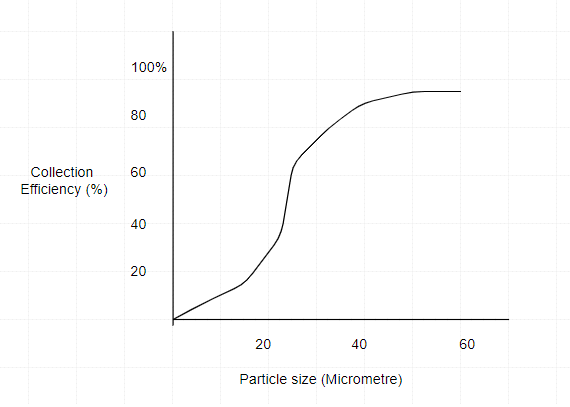
a) 82%
b) 62%
c) 42%
d) 22%
View Answer
Explanation: The collection efficiency in terms of fractional efficiency for 35 micrometres is given as:
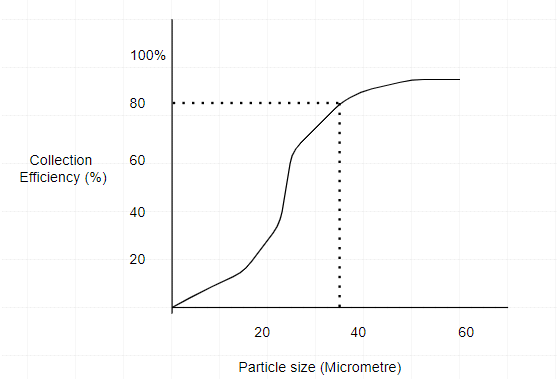
The value that corresponds with 35 microns is 80%, as observed.
15. What is the formula for collection efficiency in terms of fractional efficiency?
Where ηi is fractional efficiency, M is the total amount entering collector, and mi is the fraction collected in the given range.
a) ηT = (∑mi * ηi) * 100 / M
b) ηT = (∑mi * ηi) / M
c) ηT = (∑mi) / M
d) ηT = (∑ηi) / M
View Answer
Explanation: The correct formula for collected efficiency is:
ηi = (Weight of the material collected) * 100 / (M)
For gases containing different particle sizes,
Weight of materials collected will vary with particle size
Therefore,
Weight of the material collected = ∑mi * ηi
ηT = (∑mi * ηi) / M.
Sanfoundry Global Education & Learning Series – Air Pollution Control.
To practice all areas of Air Pollution Control, here is complete set of 1000+ Multiple Choice Questions and Answers.
If you find a mistake in question / option / answer, kindly take a screenshot and email to [email protected]
